



Ingeometry, a point group in four dimensions is an isometry group in four dimensions that leaves the origin fixed, or correspondingly, an isometry group of a 3-sphere.
There are four basic isometries of 4-dimensional point symmetry: reflection symmetry, rotational symmetry, rotoreflection, and double rotation.
This article may require cleanup to meet Wikipedia's quality standards. The specific problem is: This article is heavily disorganised with no clear sense of structure. Please help improve this article if you can. (January 2021) (Learn how and when to remove this message)
|
Point groups in this article are given in Coxeter notation, which are based on Coxeter groups, with markups for extended groups and subgroups.[6] Coxeter notation has a direct correspondence the Coxeter diagram like [3,3,3], [4,3,3], [31,1,1], [3,4,3], [5,3,3], and [p,2,q]. These groups bound the 3-sphere into identical hyperspherical tetrahedral domains. The number of domains is the order of the group. The number of mirrors for an irreducible group is nh/2, where h is the Coxeter group's Coxeter number, n is the dimension (4).[7]
For cross-referencing, also given here are quaternion based notations by Patrick du Val (1964)[8] and John Conway (2003).[9] Conway's notation allows the order of the group to be computed as a product of elements with chiral polyhedral group orders: (T=12, O=24, I=60). In Conway's notation, a (±) prefix implies central inversion, and a suffix (.2) implies mirror symmetry. Similarly Du Val's notation has an asterisk (*) superscript for mirror symmetry.
There are five involutional groups: no symmetry [ ]+, reflection symmetry [ ], 2-fold rotational symmetry [2]+, 2-fold rotoreflection [2+,2+], and central point symmetry [2+,2+,2+] as a 2-fold double rotation.
Apolychoric group is one of five symmetry groups of the 4-dimensional regular polytopes. There are also three polyhedral prismatic groups, and an infinite set of duoprismatic groups. Each group defined by a Goursat tetrahedron fundamental domain bounded by mirror planes. The dihedral angles between the mirrors determine order of dihedral symmetry. The Coxeter–Dynkin diagram is a graph where nodes represent mirror planes, and edges are called branches, and labeled by their dihedral angle order between the mirrors.
The term polychoron (plural polychora, adjective polychoric), from the Greek roots poly ("many") and choros ("room" or "space") and was advocated[10]byNorman Johnson and George Olshevsky in the context of uniform polychora (4-polytopes), and their related 4-dimensional symmetry groups.[11]
|
B4 can be decomposed into 2 orthogonal groups, 4A1 and D4:
|
|
F4 can be decomposed into 2 orthogonal D4 groups:
|
|
B3×A1 can be decomposed into orthogonal groups, 4A1 and D3:
|
Rank 4 Coxeter groups allow a set of 4 mirrors to span 4-space, and divides the 3-sphere into tetrahedral fundamental domains. Lower rank Coxeter groups can only bound hosohedronorhosotope fundamental domains on the 3-sphere.
Like the 3D polyhedral groups, the names of the 4D polychoric groups given are constructed by the Greek prefixes of the cell counts of the corresponding triangle-faced regular polytopes.[12] Extended symmetries exist in uniform polychora with symmetric ring-patterns within the Coxeter diagram construct. Chiral symmetries exist in alternated uniform polychora.
Only irreducible groups have Coxeter numbers, but duoprismatic groups [p,2,p] can be doubled to p,2,p by adding a 2-fold gyration to the fundamental domain, and this gives an effective Coxeter number of 2p, for example the [4,2,4] and its full symmetry B4, [4,3,3] group with Coxeter number 8.
| Weyl group |
Conway Quaternion |
Abstract structure |
Coxeter diagram |
Coxeter notation |
Order | Commutator subgroup |
Coxeter number (h) |
Mirrors (m) | ||||
|---|---|---|---|---|---|---|---|---|---|---|---|---|
| Full polychoric groups | ||||||||||||
| A4 | +1/60[I×I].21 | S5 | [3,3,3] | 120 | [3,3,3]+ | 5 | 10 |
|||||
| D4 | ±1/3[T×T].2 | 1/2.2S4 | [31,1,1] | 192 | [31,1,1]+ | 6 | 12 |
|||||
| B4 | ±1/6[O×O].2 | 2S4 = S2≀S4 | [4,3,3] | 384 | 8 | 4 |
12 |
|||||
| F4 | ±1/2[O×O].23 | 3.2S4 | [3,4,3] | 1152 | [3+,4,3+] | 12 | 12 |
12 |
||||
| H4 | ±[I×I].2 | 2.(A5×A5).2 | [5,3,3] | 14400 | [5,3,3]+ | 30 | 60 |
|||||
| Full polyhedral prismatic groups | ||||||||||||
| A3A1 | +1/24[O×O].23 | S4×D1 | [3,3,2] = [3,3]×[ ] | 48 | [3,3]+ | - | 6 |
1 |
||||
| B3A1 | ±1/24[O×O].2 | S4×D1 | [4,3,2] = [4,3]×[ ] | 96 | - | 3 |
6 |
1 |
||||
| H3A1 | ±1/60[I×I].2 | A5×D1 | [5,3,2] = [5,3]×[ ] | 240 | [5,3]+ | - | 15 |
1 |
||||
| Full duoprismatic groups | ||||||||||||
| 4A1 = 2D2 | ±1/2[D4×D4] | D14 = D22 | [2,2,2] = [ ]4 = [2]2 | 16 | [ ]+ | 4 | 1 |
1 |
1 |
1 | ||
| D2B2 | ±1/2[D4×D8] | D2×D4 | [2,2,4] = [2]×[4] | 32 | [2]+ | - | 1 |
1 |
2 |
2 | ||
| D2A2 | ±1/2[D4×D6] | D2×D3 | [2,2,3] = [2]×[3] | 24 | [3]+ | - | 1 |
1 |
3 |
|||
| D2G2 | ±1/2[D4×D12] | D2×D6 | [2,2,6] = [2]×[6] | 48 | - | 1 |
1 |
3 |
3 | |||
| D2H2 | ±1/2[D4×D10] | D2×D5 | [2,2,5] = [2]×[5] | 40 | [5]+ | - | 1 |
1 |
5 |
|||
| 2B2 | ±1/2[D8×D8] | D42 | [4,2,4] = [4]2 | 64 | [2+,2,2+] | 8 | 2 |
2 |
2 |
2 | ||
| B2A2 | ±1/2[D8×D6] | D4×D3 | [4,2,3] = [4]×[3] | 48 | [2+,2,3+] | - | 2 |
2 |
3 |
|||
| B2G2 | ±1/2[D8×D12] | D4×D6 | [4,2,6] = [4]×[6] | 96 | - | 2 |
2 |
3 |
3 | |||
| B2H2 | ±1/2[D8×D10] | D4×D5 | [4,2,5] = [4]×[5] | 80 | [2+,2,5+] | - | 2 |
2 |
5 |
|||
| 2A2 | ±1/2[D6×D6] | D32 | [3,2,3] = [3]2 | 36 | [3+,2,3+] | 6 | 3 |
3 |
||||
| A2G2 | ±1/2[D6×D12] | D3×D6 | [3,2,6] = [3]×[6] | 72 | - | 3 |
3 |
3 | ||||
| 2G2 | ±1/2[D12×D12] | D62 | [6,2,6] = [6]2 | 144 | 12 | 3 |
3 |
3 |
3 | |||
| A2H2 | ±1/2[D6×D10] | D3×D5 | [3,2,5] = [3]×[5] | 60 | [3+,2,5+] | - | 3 |
5 |
||||
| G2H2 | ±1/2[D12×D10] | D6×D5 | [6,2,5] = [6]×[5] | 120 | - | 3 |
3 |
5 |
||||
| 2H2 | ±1/2[D10×D10] | D52 | [5,2,5] = [5]2 | 100 | [5+,2,5+] | 10 | 5 |
5 |
||||
| In general, p,q=2,3,4... | ||||||||||||
| 2I2(2p) | ±1/2[D4p×D4p] | D2p2 | [2p,2,2p] = [2p]2 | 16p2 | [p+,2,p+] | 2p | p |
p |
p |
p | ||
| 2I2(p) | ±1/2[D2p×D2p] | Dp2 | [p,2,p] = [p]2 | 4p2 | 2p | p |
p |
|||||
| I2(p)I2(q) | ±1/2[D4p×D4q] | D2p×D2q | [2p,2,2q] = [2p]×[2q] | 16pq | [p+,2,q+] | - | p |
p |
q |
q | ||
| I2(p)I2(q) | ±1/2[D2p×D2q] | Dp×Dq | [p,2,q] = [p]×[q] | 4pq | - | p |
q |
|||||
The symmetry order is equal to the number of cells of the regular polychoron times the symmetry of its cells. The omnitruncated dual polychora have cells that match the fundamental domains of the symmetry group.
| Symmetry | A4 | D4 | B4 | F4 | H4 | |
|---|---|---|---|---|---|---|
| 4-polytope | 5-cell | demitesseract | tesseract | 24-cell | 120-cell | |
| Cells | 5 {3,3} | 16 {3,3} | 8 {4,3} | 24 {3,4} | 120 {5,3} | |
| Cell symmetry | [3,3], order 24 | [4,3], order 48 | [5,3], order 120 | |||
| Coxeter diagram | ||||||
| 4-polytope net |

|
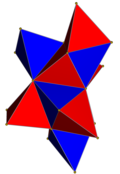
|
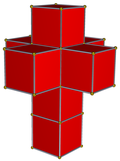
|
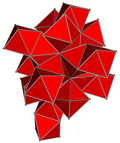
|
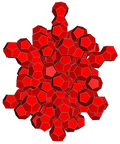
| |
| Omnitruncation | omni. 5-cell | omni. demitesseract | omni. tesseract | omni. 24-cell | omni. 120-cell | |
| Omnitruncation dual net |
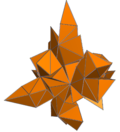
|
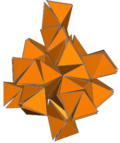
|
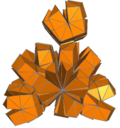
|
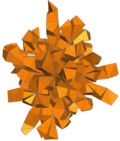
|

| |
| Coxeter diagram | ||||||
| Cells | 5×24 = 120 | (16/2)×24 = 192 | 8×48 = 384 | 24×48 = 1152 | 120×120 = 14400 | |



Direct subgroups of the reflective 4-dimensional point groups are:
| Coxeter notation |
Conway Quaternion |
Structure | Order | Gyration axes | ||||
|---|---|---|---|---|---|---|---|---|
| Polychoric groups | ||||||||
| [3,3,3]+ | +1/60[I×I] | A5 | 60 | 103 |
102 | |||
| 3,3,3+ | ±1/60[I×I] | A5×Z2 | 120 | 103 |
(10+?)2 | |||
| [31,1,1]+ | ±1/3[T×T] | 1/2.2A4 | 96 | 163 |
182 | |||
| [4,3,3]+ | ±1/6[O×O] | 2A4 = A2≀A4 | 192 | 64 |
163 |
362 | ||
| [3,4,3]+ | ±1/2[O×O] | 3.2A4 | 576 | 184 |
163 |
163 |
722 | |
| [3+,4,3+] | ±[T×T] | 288 | 163 |
163 |
(72+18)2 | |||
| [[3+,4,3+]] | ±[O×T] | 576 | 323 |
(72+18+?)2 | ||||
| 3,4,3+ | ±[O×O] | 1152 | 184 |
323 |
(72+?)2 | |||
| [5,3,3]+ | ±[I×I] | 2.(A5×A5) | 7200 | 725 |
2003 |
4502 | ||
| Polyhedral prismatic groups | ||||||||
| [3,3,2]+ | +1/24[O×O] | A4×Z2 | 24 | 43 |
43 |
(6+6)2 | ||
| [4,3,2]+ | ±1/24[O×O] | S4×Z2 | 48 | 64 |
83 |
(3+6+12)2 | ||
| [5,3,2]+ | ±1/60[I×I] | A5×Z2 | 120 | 125 |
203 |
(15+30)2 | ||
| Duoprismatic groups | ||||||||
| [2,2,2]+ | +1/2[D4×D4] | 8 | 12 |
12 |
42 | |||
| [3,2,3]+ | +1/2[D6×D6] | 18 | 13 |
13 |
92 | |||
| [4,2,4]+ | +1/2[D8×D8] | 32 | 14 |
14 |
162 | |||
| (p,q=2,3,4...), gcd(p,q)=1 | ||||||||
| [p,2,p]+ | +1/2[D2p×D2p] | 2p2 | 1p |
1p |
(pp)2 | |||
| [p,2,q]+ | +1/2[D2p×D2q] | 2pq | 1p |
1q |
(pq)2 | |||
| [p+,2,q+] | +[Cp×Cq] | Zp×Zq | pq | 1p |
1q |
|||
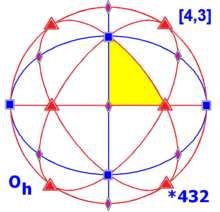




 , octahedral pyramidal group is isomorphic to 3d octahedral symmetry
, octahedral pyramidal group is isomorphic to 3d octahedral symmetry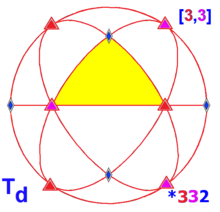




 , tetrahedral pyramidal group is isomorphic to 3d tetrahedral symmetry
, tetrahedral pyramidal group is isomorphic to 3d tetrahedral symmetry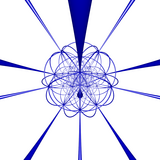 [5,3,3]+ 72 order-5 gyrations |
 [5,3,3]+ 200 order-3 gyrations |
 [5,3,3]+ 450 order-2 gyrations |
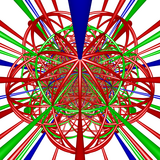 [5,3,3]+ all gyrations |
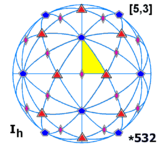 [5,3], |
This is a summary of 4-dimensional point groupsinCoxeter notation. 227 of them are crystallographic point groups (for particular values of p and q).[14][which?] (nc) is given for non-crystallographic groups. Some crystallographic group[which?] have their orders indexed (order.index) by their abstract group structure.[15]
| Finite groups | ||||||||||||||||||||||||||||||||||||||||||||||||||||||||||||||||||||||||||||||||||||||||||||||||||||||||||||||||||||||||||||||||||||||||||||||||||||||||||||||||||||||||||||||||||||||||||||||||||||||||||||||||||||||||||||||||||||||||||||||||||||||||||||||||||||||||||||||||||||||||||||||||||||
|---|---|---|---|---|---|---|---|---|---|---|---|---|---|---|---|---|---|---|---|---|---|---|---|---|---|---|---|---|---|---|---|---|---|---|---|---|---|---|---|---|---|---|---|---|---|---|---|---|---|---|---|---|---|---|---|---|---|---|---|---|---|---|---|---|---|---|---|---|---|---|---|---|---|---|---|---|---|---|---|---|---|---|---|---|---|---|---|---|---|---|---|---|---|---|---|---|---|---|---|---|---|---|---|---|---|---|---|---|---|---|---|---|---|---|---|---|---|---|---|---|---|---|---|---|---|---|---|---|---|---|---|---|---|---|---|---|---|---|---|---|---|---|---|---|---|---|---|---|---|---|---|---|---|---|---|---|---|---|---|---|---|---|---|---|---|---|---|---|---|---|---|---|---|---|---|---|---|---|---|---|---|---|---|---|---|---|---|---|---|---|---|---|---|---|---|---|---|---|---|---|---|---|---|---|---|---|---|---|---|---|---|---|---|---|---|---|---|---|---|---|---|---|---|---|---|---|---|---|---|---|---|---|---|---|---|---|---|---|---|---|---|---|---|---|---|---|---|---|---|---|---|---|---|---|---|---|---|---|---|---|---|---|---|---|---|---|---|---|---|---|---|---|---|---|---|---|---|---|---|---|---|---|---|---|---|---|---|---|---|---|---|---|
|
|
|
|
| ||||||||||||||||||||||||||||||||||||||||||||||||||||||||||||||||||||||||||||||||||||||||||||||||||||||||||||||||||||||||||||||||||||||||||||||||||||||||||||||||||||||||||||||||||||||||||||||||||||||||||||||||||||||||||||||||||||||||||||||||||||||||||||||||||||||||||||||||||||||||||||||||